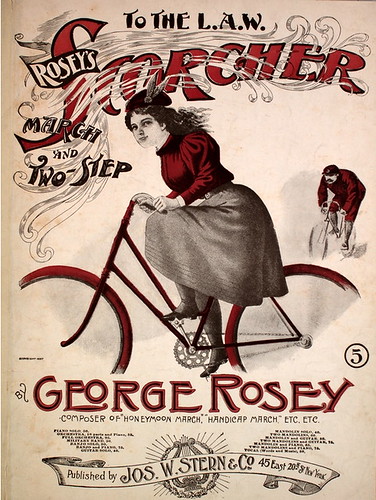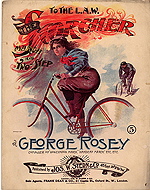Ray LaHood, John the Scorcher, some bloomers and a bunch of brigands
When, in 2010, US Transport Secretary Ray LaHood promised “we are holding Toyota’s feet to the fire” over the accelerator-pedal car recall of that year he likely didn’t know there was a back-story to this fiery phrase, and that – via the word chauffeur and some feet-toasting bad ‘uns – it relates to the pre-history of motoring, and can even be linked to cycling.
According to the Merriam Webster dictionary, the word chauffeur means stoker, from chauffer ‘to heat’, which in turn is from Old French, chaufer ‘to heat, rub with the hands to make warm’ whence we get a word familiar to cyclists: chafe. Its meaning “to make sore by rubbing” was current by the 1500s.
Both the Online Etymology Dictionary and Wikipedia link the word chauffeur to stoker:
“The earliest automobiles, like their railroad and sea vessel counterparts, were steam-powered and required the driver to pre-heat the engine to produce energy, thus, the French term for stoker was adapted.”
But, as with many words, there can be other derivations and there’s perhaps a good case for an earlier definition to be used. The online archive of Popular Science magazine is a fascinating time-sink. Here’s a following definition of the word chauffeur, from the June 1918 issue of PopSci:
“It seems that the word chauffeur means ‘scorcher’. Over a century ago, some particularly brigandish brigands lived on the borderland between France and Germany. To force ransoms from their captives, these desperadoes grilled the soles of their victims’ feet before a fierce fire. So the countryfolk referred to the band as scorchers or, in French, chauffeurs.
“Not so many years back, when these same imaginative French were in need of a descriptive name for motor-car drivers, they hit upon the word chauffeur. Just how much ‘scorching’ of a more modern kind these up-to-date brigands of the road indulge in is best divulged by police records of fines for speeding.”
So, an early word for ‘motorist’ – before it morphed into its current servile meaning – was chauffeur, and this was linked to a word for speeding.
As with many things motoring, bicycle riders got there first. Scorching might have been used of speeding motorists by 1918 but it was used earlier than this for bicycle boom riders of the 1880s-1890s. Scorchers were riders who wanted to go fast, and bicycles were advertised by manufacturers as ‘scorchers’.
In an American book on ‘how to bicycle’ from 1892, L. F. Korns wrote:
“As a means of pleasure, cycling stands in the foremost rank, but in common with all the great pleasures, it may easily stand in the foremost in abuse. The desire to ride at an unreasonably high speed may become morbid…The ever lasting scorcher, bent like a hoop, and with sunken cheeks, ought to be quite sufficient warning against this abuse.”

Naturally, ‘scorching’ was not seen by cyclists as an abuse. It was a badge of pride, an athletic accomplishment.
19th-century author Louis Baudry de Saunier thought the speed-crazed bicyclist was a blend of man-and-machine: “The cyclist is a man half made of flesh and half of steel that only our century of science and iron could have spawned.”
But, as famously described by American women’s rights leader Susan B. Anthony in 1896, cycling was also one of the key tools of female emancipation:
“I’ll tell you what I think of bicycling. I think it has done more to emancipate women than any one thing in the world. I rejoice every time I see a woman ride by on a bike. It gives her a feeling of self-reliance and independence the moment she takes her seat; and away she goes, the picture of untrammelled womanhood.”
Anthony, like her friend and fellow feminist Amelia Bloomer, advocated universal suffrage but also called for ‘rational dress’, the fashion for less restricting women’s garments. Bloomer didn’t invent the leggings named for her, but she popularised them. ‘Athletic bloomers’ allowed women to cycle more easily.
It’s interesting that in this sheet-music cover for a popular tune of 1897, the publisher has started off with the ‘scorcher’ heroine in a dress…

…but she was later shown wearing bloomers, also known as ‘rationals’, relatively radical attire for the day:

But enough about bloomers, let’s get back to those Franco-German brigands. A quick tappity-tap into a popular search engine and out pops the name John the Scorcher; in German, Schinderhannes. He’s the German equivalent of Robin Hood, although, unlike Nottingham’s favourite son, he’s a genuine historical figure. The Robber of the Rhine was executed in 1803.
According to The Book of Days:
[The brigands] were often called Chauffeurs or Scorchers; because they were accustomed to hold the soles of their victims’ feet in front of a fierce fire, to extort a revelation of the place where their property was concealed…Each band had a camp or rendezvous, with lines of communication throughout a particular district. The posts on these lines were generally poor country taverns, the landlords of which were in league with the band. And not only was this the case, but from Holland to the Danube, the chauffeurs could always obtain friendly shelter at these houses, with means for exchanging intelligence with others of the fraternity.
Schinderhannes, or ‘John the Scorcher,’ was the most famous of all the leaders of these robbers. His real name was Johann Buckler; but his practice of chauffage, or scorching the feet of his victims, earned for him the appellation of Schinderhannes. Born in 1779, near the Rhine, he from early years loved the society of those who habitually braved all law and control.”
If PopSci is right, and Merriam Webster is incomplete, via the word chauffeur we can link together Ray LaHood, the Robber of the Rhine, speeding motorists, and ‘scorcher’ cyclists.
Speeding motorists and cyclists have never mixed. Evylyn Thomas of New York could attest to that. On May 30th 1896 she became the first cyclist to be run over and injured by a motorist (or at least first to be so reported). The New-York Daily Tribune of the time recounted the incident thus:
“The wagon [automobile] operated by Henry Wells, of Springfield, Mass., wobbled furiously, going in a zig-zag fashion, until it seemed that the driver had lost control of it. Evylyn Thomas, of No. 459 West Ninetieth-st., was approaching on her bicycle, when suddenly the wheel and horseless carriage met, and there was a crash. A crowd gathered, and the woman was picked up unconscious, her leg fractured. An ambulance took her to the Manhattan Hospital, where last night it was reported that she would recover soon. Wells was taken to the West One-hundred-and-twenty-fifth-st. station, and held pending the result of the injuries to Miss Thomas. The wagon went on in charge of another operator.”
The newspaper didn’t state whether it was Miss Thomas or Mr Wells who was guilty of “scorching”.
